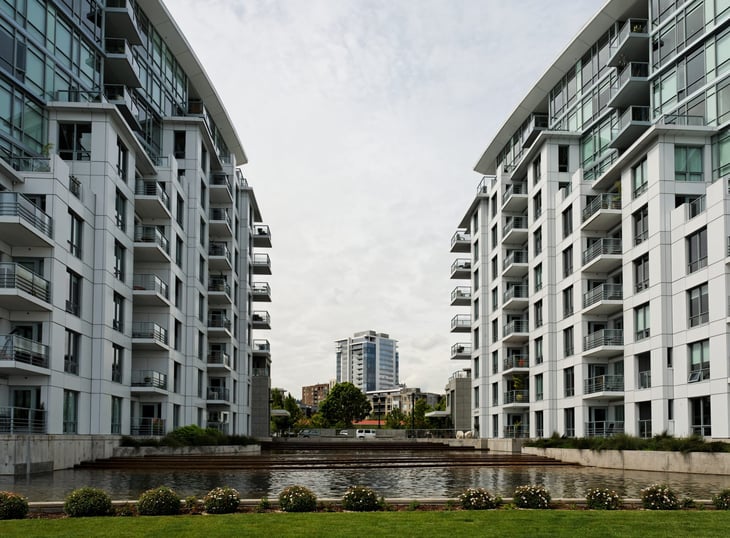
Editor's Note: This story originally appeared on Point2.
With inflation and the Fed’s rate hikes affecting both rents and mortgage affordability, it seems as though there’s no end in sight for home seekers’ trials and tribulations.
Now, even the tiniest hopes at homeownership — which looked attainable when mortgage rates were still low — are currently being crushed by the harsh financial reality of the day: Keeping inflation in check is not compatible with the American dream.
In retrospect, the low mortgage rates acted like a thin veil separating homebuyers from increasingly worrisome home prices. But, given the recent attempts aimed at reducing inflation, that thin veil is lifting.
The jarring home prices are deepening the mortgage affordability crisis, while rental inflation ensures that renters, as well as homebuyers, will face tougher conditions.
Following is a look at how home prices have shifted in America’s biggest metropolitan areas over the past decade.
In 3 Metros, the Average Homeowner Became a Property Millionaire in Just 10 Years

Home prices in San Jose, California; San Francisco; and Anaheim, California, more than doubled and crossed the $1 million psychological barrier in the last decade, with urban Honolulu joining their ranks in 2022.
In the last 10 years, the median price of a U.S. single-family home more than doubled, going from $166,200 in 2011 to $353,600 in 2021. And, for the second quarter of 2022, the National Association of Realtors reported a new high price — $414,000, which is an increase of 14% year-over-year. What’s more, it’s almost the same story for condos: Nationally, median condo prices increased by $132,300 between 2011 and 2021 — an 80% jump. The median is currently $351,200, per Q2 2022 data.
But, no matter how impressive these amounts and percentages are, they’re still national averages. Metro- and city-level data reveal a much more colorful heatmap of price changes. From just under 10% to more than 350%, single-family home prices increased in all of the 187 metros included in the analysis. While Detroit and Boise, Idaho, stood out with 357% and 307% increases, respectively, prices more than doubled in 69 other metros, compared to 2011.
When it came to net increases, the absolute winner was the San Jose real estate market: Home prices in this California metro rose more than $1 million, reaching $1.64 million in 2021 and $1.9 million in Q2 2022. In other words, between January 2011 and December 2021, home prices here increased by an average of $266 per day. Coming in second, San Francisco homes added an average of $208 every day for 10 years, going from a little less than $500,000 in 2011 to a median of $1.32 million in 2021.
The top three metros where home prices added the most money per day were also the three metros that crossed the $1 million mark in 10 years or less: San Jose, San Francisco, and Anaheim. While this may not be that surprising, what is surprising is that urban Honolulu joined their ranks in Q1 2022 — despite not having some of the most rapidly growing home prices: Although it only added $99 per day, on average, since 2011 (surpassed by faster-growing markets like Los Angeles; San Diego; Boulder, Colorado; and Seattle) the Hawaii capital flew by the $1 million threshold just one year later than the first three metros that reached this milestone.
Large Metros Data

Of the 59 large metros in the analysis, Detroit, Phoenix, and Atlanta saw the largest percentage gains, but San Jose, San Francisco, and Anaheim recorded the most substantial net increases.
Detroit — along with Phoenix; Atlanta; Las Vegas; and Sacramento, California — may have seen the most impressive percentage increases, but home prices in these areas still can’t compare with some of the most expensive cities and metros. For example, looking at net increases, San Jose added an average of $266 every day. San Francisco added $208 on average, while homes in Anaheim, Los Angeles, San Diego, and Seattle each added more than $100 per day.
In 2020, real estate agents and professionals in Detroit — and most other metros and cities across the U.S. — were talking about the same market features leading to the unprecedented price growth: Low inventory; increasing demand; supply chain and construction snags; more buyers prioritizing more spacious homes; and older generations being far less open to downsizing than before.
Yet, like Detour Detroiter emphasized, the pandemic and the need for more space that it brought about were only the last pieces in a puzzle that recreated the profile of the new American homebuyer: a highly motivated, middle- or high-income buyer who wants more space and can make the move to homeownership. According to the agents interviewed for the article:
“In Detroit, the price increases are being driven largely by sales of single-family home sales over $450,000. Homes at those upper-tier prices have seen prices increase 12.2% year-over-year. Meanwhile, the sale price for condos, which are typically smaller and rarely have private yards, have been flat.
The upwardly trending sale numbers and prices may also be masking some underlying issues. Black said that the housing market is currently “isolated by area and income brackets.” Move-in ready homes in stable Detroit neighborhoods both at the high-end and the middle have been rising. […] However, the average sale price for homes under $250,000 has increased by less than 3%.”
In Phoenix, the situation closely resembles that of other metros: More millennials are reaching an age where they want and can afford to buy a home, but they have to contend with low inventory and a slowed pace of new home construction.
However, a Time investigation revealed another reason for which homes in Phoenix had the second-fastest growing prices of all of the large metros in the nation: More people have opted to move here than almost anywhere else in the U.S.
“The Phoenix metropolitan area has been one of the fastest growing regions of the U.S. for several years, growing about 20% in a decade. But recently that growth has been sharper; in 2020, 291 people moved to Maricopa County per day, according to some estimates. One of the reasons they moved there—so they could have a yard and some space in a city where more than two thirds of homes are single family dwellings—is also one of the reasons it’s suffering such a housing shortage. In the same decade as its population has blossomed, the number of residential units grew by only 11%.”
At the same time, the third-fastest growing metro on the list — Atlanta — has been deemed one of the most overvalued housing markets in the country: According to a recent analysis by researchers at Florida Atlantic University and Florida International University, Atlanta is currently one of 20 metro areas where home prices are inflated by 50% or more.
And, while analyses about overvalued and undervalued housing markets can be speculative, with many local particularities contributing to the final ranking, many homebuyers are aware that they might not be able to resell their home for the same price.
Midsized Metros Data

Although Boise, Idaho, saw the largest percentage increase in home prices compared to 2011 (at 307%), it was Naples, Florida, and Boulder, Colorado, that added the largest net amounts.
Naples and Boulder were the only two midsized metros in the analysis where medians increased by more than $400,000 in the full decade between 2011 and 2021. That translates to a daily average addition of a little more than $100. That said, two more metros also stood out with 10-year additions of more than $350,000: Homes for sale in Reno, Nevada, and Boise are becoming increasingly more expensive.
However, while these stats may make homeowners and home sellers happy, they have the opposite effect on buyers. For example, Boise used to be the epitome of affordability and outdoorsy lifestyle — a combination that was simply irresistible to remote workers from areas plagued by unaffordability and crammed living spaces.
But now, Boise is considered to be the most overvalued housing market in the country. Moreover, the same workers who drove up prices and completely upended the market are now heading back to the new normal in their former cities of residence. In the process, they’re leaving behind what will likely soon look like an abandoned Zoom Town. According to The Wall Street Journal:
“Now, the housing boom around Idaho’s capital city has ground to a halt. Buyers are balking at record prices and mortgage rates that last month hit a 13-year high. Sixty-one percent of listings in the Boise metro area had a price cut in June, the highest rate out of 97 metro areas surveyed, according to brokerage Redfin Corp. Home builders who couldn’t keep up with demand last year are cutting back on construction.”
Although Boise stole the limelight due to its 307% increase, no fewer than 31 of the 93 midsized metros in the analysis also saw triple-digit home price growth — meaning their prices at least doubled compared to 2011. And, four metros truly followed in the footsteps of Boise: Three Florida markets (Naples, Cape Coral, and Port St. Lucie), as well as Reno, Nevada, recorded price jumps of between 200% and 270%.
Meanwhile, in the other 62 midsized markets, home prices increased by 99% or less. Peoria, Illinois, was the only midsized metro where single-family home prices increased by less than 10% — the smallest percentage increase of all of the markets. This metro also recorded the least-significant net increase — $10,700 since 2011, or an average of $3 per day.
Small Metros Data

Five small metros saw home prices more than double in the last 10 years, with increases of between 110% and 223%, whereas Barnstable, Massachusetts, recorded the most significant net increase — $306,300.
Home prices in Punta Gorda, Florida; Sherman-Denison, Texas; Sebastian-Vero Beach, Florida; Saginaw, Michigan; and Panama City, Florida, recorded explosive growth, with most of them more than doubling in a decade. However, Barnstable was the small metro that saw the largest net increase. In fact, the Massachusetts town was the most expensive small metro on the list, with a Q2 2022 price of $721,800.
A quiet suburb north of Fort Myers, Florida, and an exclusively residential area, Punta Gorda has many things going for it. The highly affordable homes, along with the suburb’s amazing location, began attracting retirees and second homebuyers to the area as far back as the early 2010s. Understandably, it also became a magnet for remote workers once the pandemic started wreaking havoc. According to CNN:
“Punta Gorda’s housing market has two huge factors working in its favor: very low home prices and extremely nice backyards. […] Many of the homes sit canal-side and have docks in their backyards. Homeowners can jump in their boats and be in the Gulf of Mexico in a matter of minutes. […] Maintenance costs, especially property taxes, are low as well.”
With such intense demand, it’s no wonder that this small metro area saw home prices explode in the last 10 years. But, although Punta Gorda homes led the way when it came to percentage increases, two New York metros added the largest net amounts of all of the small metros: Single-family home prices in Glen Falls, New York, and Rochester, New York, increased by almost $75,000 and $72,400, respectively.
At the other end of the spectrum, Bloomington, Illinois, recorded the least-significant price increase of all of the small metros on the list. At 19%, this was the only price change below 20%, with all of the other 34 small metros looking at increases higher than 20%. And, which small metros added almost negligible net amounts, by comparison? Home prices in Abilene, Texas; Saginaw, Michigan; and Decatur, Alabama, increased by less than $100,000 in the last decade.
Condo Price Evolution Data

With a 544% increase in condo prices since 2011, Atlanta blew all other metros out of the water, while Hartford, Connecticut, was at the end of the ranking, with a meager 6% increase.
In most metros, the staggering home price increases were mostly driven by increases in single-family home prices, cementing the idea that this was and remains Americans’ preferred type of housing. But, that’s what makes the increases in condo prices even more telling: Many homebuyers are priced out of the single-family segment, but are willing to compromise in order to fulfill their dreams of homeownership.
As the more affordable option compared to single-family houses, condos are seeing increased demand from homebuyers who want to get on the ladder, but can’t come anywhere near the astronomical prices and increasing mortgage rates in the single-family home segment. Although condos became almost taboo for a period of time during the pandemic, as COVID-19 cases decline, city life — and, therefore, condo life — is making a comeback.
Judging by the huge increases in prices, the markets where demand for condos has really been accelerating are Atlanta, Reno, and Las Vegas. According to the Federal Reserve Bank’s 2022 index, the metro Atlanta housing market is unaffordable. And, metros like Reno and Las Vegas can’t be far behind, given that they trail Atlanta in condo price increases, with jumps of 430% and almost 300%, respectively.
Meanwhile, looking at the markets where condo prices barely budged compared to 2011, Hartford and New Haven, Connecticut, stood out. Boasting the lowest percentage and net gains, condo prices in these two metro areas haven’t changed that much compared to 10 years ago, hovering around $175,000.
According to one of the most recent NAR reports, both condo and single-family home prices are still going up, while sales are starting to fall:
“Single-family home sales declined to a seasonally adjusted annual rate of 4.31 million in July, down 5.5% from 4.56 million in June and down 19.0% from one year ago. The median existing single-family home price was $410,600 in July, up 10.6% from July 2021.
Existing condominium and co-op sales were recorded at a seasonally adjusted annual rate of 500,000 units in July, down 9.1% from June and down 29.6% from one year ago. The median existing condo price was $345,000 in July, an annual increase of 9.9%.”
This could point to the fact that buyers might start to regain some control over prices. But, with inflation still running rampant (and so many other moving parts on the table) the next few months could be better spent by simply taking stock of and reevaluating attitudes toward buying.
Methodology

For this study, we analyzed single-family detached home prices and condominium and co-op prices in all of the metro areas, as well as the national and regional areas reported by the National Association of Realtors in their latest quarterly report. The most recent data available was from Q2 2022 and the most recent full-year data, which we used for comparison purposes, is 2021 (full-year data).
Where the National Association of Realtors had incomplete or missing data for 2011, we looked at local MLS historical reports, local city reports, articles and Zillow data.
We divided the metros into three categories based on their population:
- Large metros had a population equal to or more than 1,000,000 residents.
- Medium metros had a population equal to or more than 250,000 residents, but less than 1,000,000.
- Small metros had a population less than 250,000.
We compared home prices in 2021 with those in 2011 and ranked the metros based on their percentage and net changes during this past decade.





Add a Comment
Our Policy: We welcome relevant and respectful comments in order to foster healthy and informative discussions. All other comments may be removed. Comments with links are automatically held for moderation.